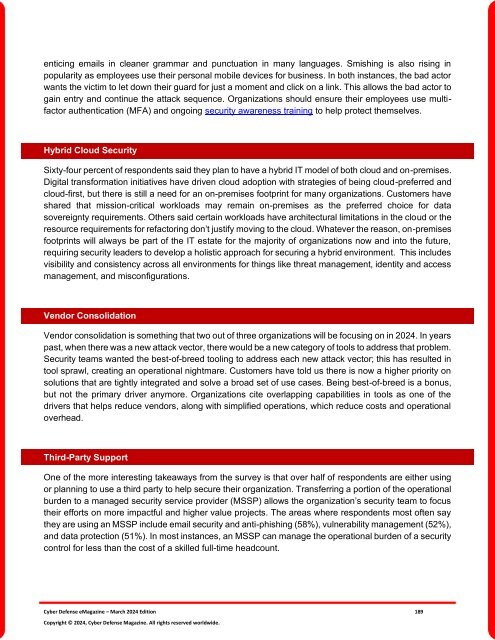The Cyber Defense eMagazine March Edition for 2024
Cyber Defense eMagazine March Edition for 2024 #CDM #CYBERDEFENSEMAG @CyberDefenseMag by @Miliefsky a world-renowned cyber security expert and the Publisher of Cyber Defense Magazine as part of the Cyber Defense Media Group as well as Yan Ross, Editor-in-Chief and many more writers, partners and supporters who make this an awesome publication! 225 page March Edition fully packed with some of our best content. Thank you all and to our readers! OSINT ROCKS! #CDM #CDMG #OSINT #CYBERSECURITY #INFOSEC #BEST #PRACTICES #TIPS #TECHNIQUES
Cyber Defense eMagazine March Edition for 2024 #CDM #CYBERDEFENSEMAG @CyberDefenseMag by @Miliefsky a world-renowned cyber security expert and the Publisher of Cyber Defense Magazine as part of the Cyber Defense Media Group as well as Yan Ross, Editor-in-Chief and many more writers, partners and supporters who make this an awesome publication! 225 page March Edition fully packed with some of our best content. Thank you all and to our readers! OSINT ROCKS! #CDM #CDMG #OSINT #CYBERSECURITY #INFOSEC #BEST #PRACTICES #TIPS #TECHNIQUES
Create successful ePaper yourself
Turn your PDF publications into a flip-book with our unique Google optimized e-Paper software.
enticing emails in cleaner grammar and punctuation in many languages. Smishing is also rising in<br />
popularity as employees use their personal mobile devices <strong>for</strong> business. In both instances, the bad actor<br />
wants the victim to let down their guard <strong>for</strong> just a moment and click on a link. This allows the bad actor to<br />
gain entry and continue the attack sequence. Organizations should ensure their employees use multifactor<br />
authentication (MFA) and ongoing security awareness training to help protect themselves.<br />
Hybrid Cloud Security<br />
Sixty-four percent of respondents said they plan to have a hybrid IT model of both cloud and on-premises.<br />
Digital trans<strong>for</strong>mation initiatives have driven cloud adoption with strategies of being cloud-preferred and<br />
cloud-first, but there is still a need <strong>for</strong> an on-premises footprint <strong>for</strong> many organizations. Customers have<br />
shared that mission-critical workloads may remain on-premises as the preferred choice <strong>for</strong> data<br />
sovereignty requirements. Others said certain workloads have architectural limitations in the cloud or the<br />
resource requirements <strong>for</strong> refactoring don’t justify moving to the cloud. Whatever the reason, on-premises<br />
footprints will always be part of the IT estate <strong>for</strong> the majority of organizations now and into the future,<br />
requiring security leaders to develop a holistic approach <strong>for</strong> securing a hybrid environment. This includes<br />
visibility and consistency across all environments <strong>for</strong> things like threat management, identity and access<br />
management, and misconfigurations.<br />
Vendor Consolidation<br />
Vendor consolidation is something that two out of three organizations will be focusing on in <strong>2024</strong>. In years<br />
past, when there was a new attack vector, there would be a new category of tools to address that problem.<br />
Security teams wanted the best-of-breed tooling to address each new attack vector; this has resulted in<br />
tool sprawl, creating an operational nightmare. Customers have told us there is now a higher priority on<br />
solutions that are tightly integrated and solve a broad set of use cases. Being best-of-breed is a bonus,<br />
but not the primary driver anymore. Organizations cite overlapping capabilities in tools as one of the<br />
drivers that helps reduce vendors, along with simplified operations, which reduce costs and operational<br />
overhead.<br />
Third-Party Support<br />
One of the more interesting takeaways from the survey is that over half of respondents are either using<br />
or planning to use a third party to help secure their organization. Transferring a portion of the operational<br />
burden to a managed security service provider (MSSP) allows the organization’s security team to focus<br />
their ef<strong>for</strong>ts on more impactful and higher value projects. <strong>The</strong> areas where respondents most often say<br />
they are using an MSSP include email security and anti-phishing (58%), vulnerability management (52%),<br />
and data protection (51%). In most instances, an MSSP can manage the operational burden of a security<br />
control <strong>for</strong> less than the cost of a skilled full-time headcount.<br />
<strong>Cyber</strong> <strong>Defense</strong> <strong>eMagazine</strong> – <strong>March</strong> <strong>2024</strong> <strong>Edition</strong> 189<br />
Copyright © <strong>2024</strong>, <strong>Cyber</strong> <strong>Defense</strong> Magazine. All rights reserved worldwide.

















